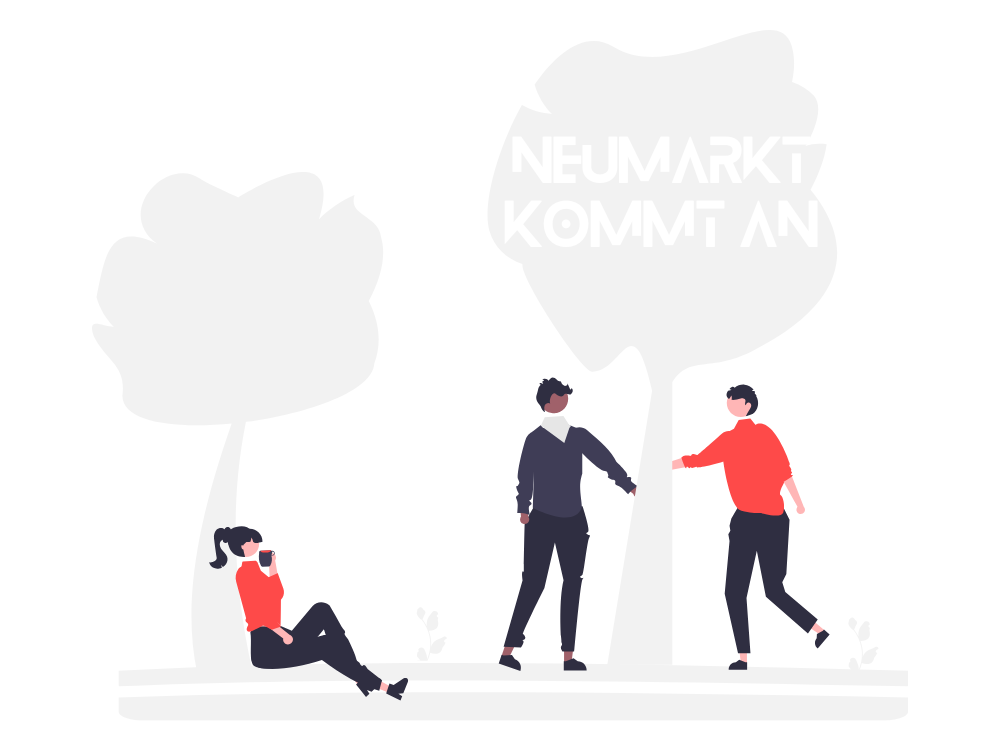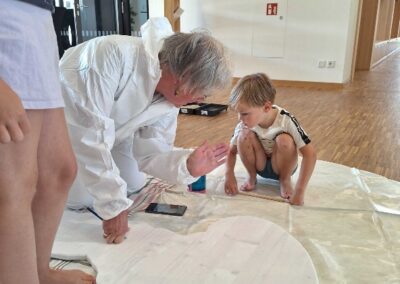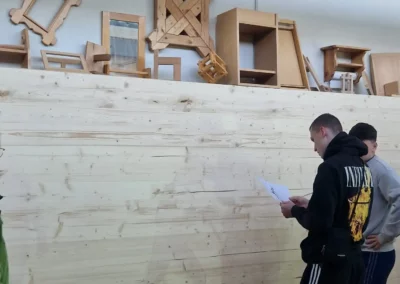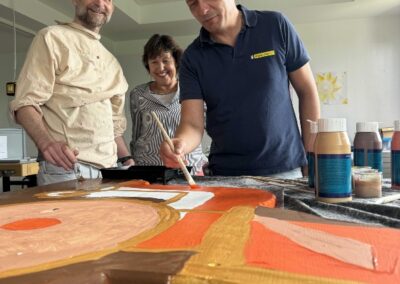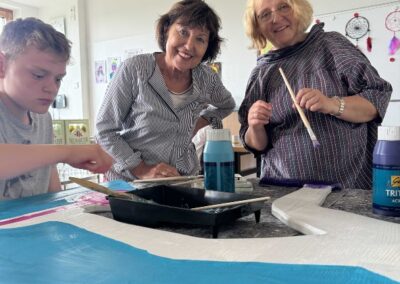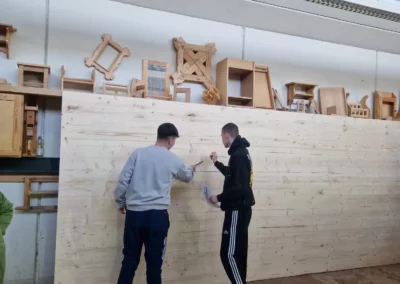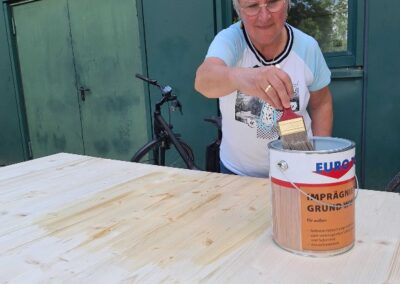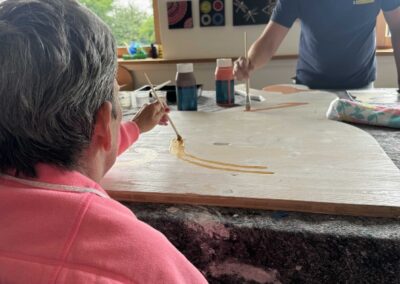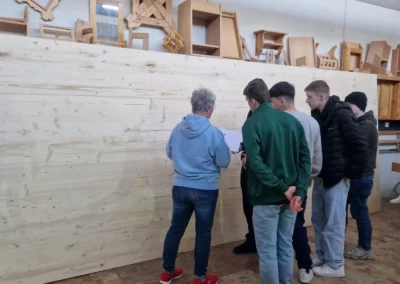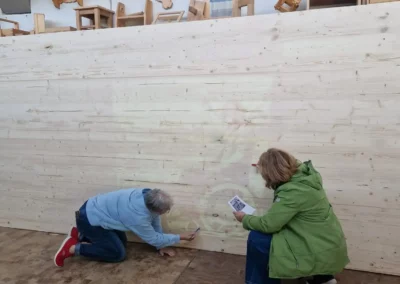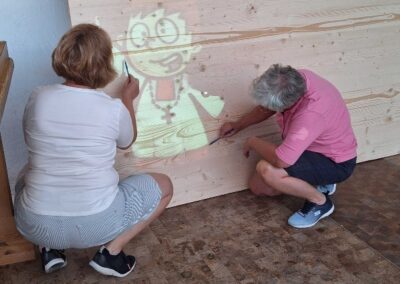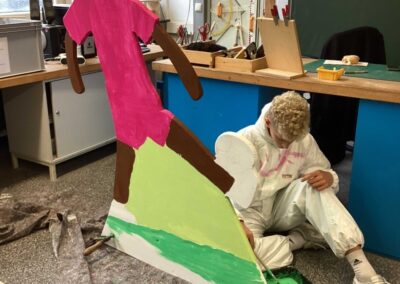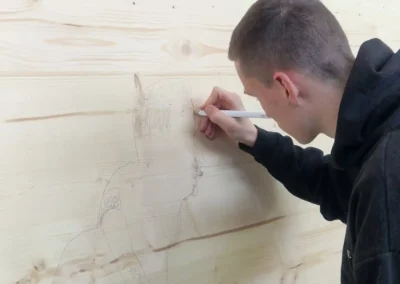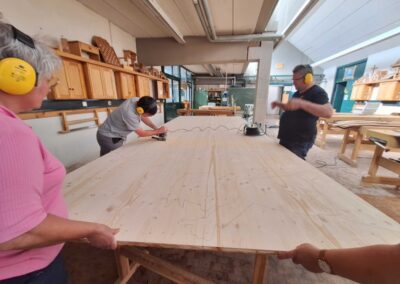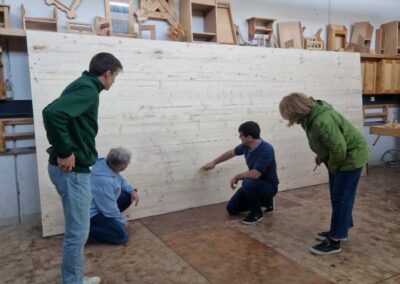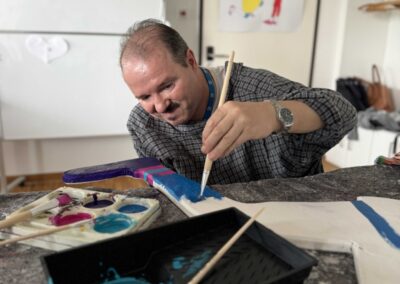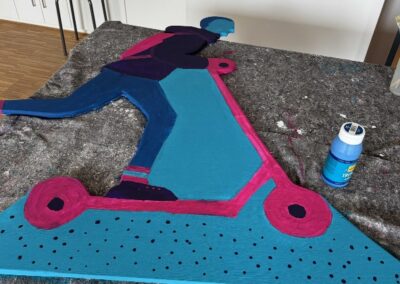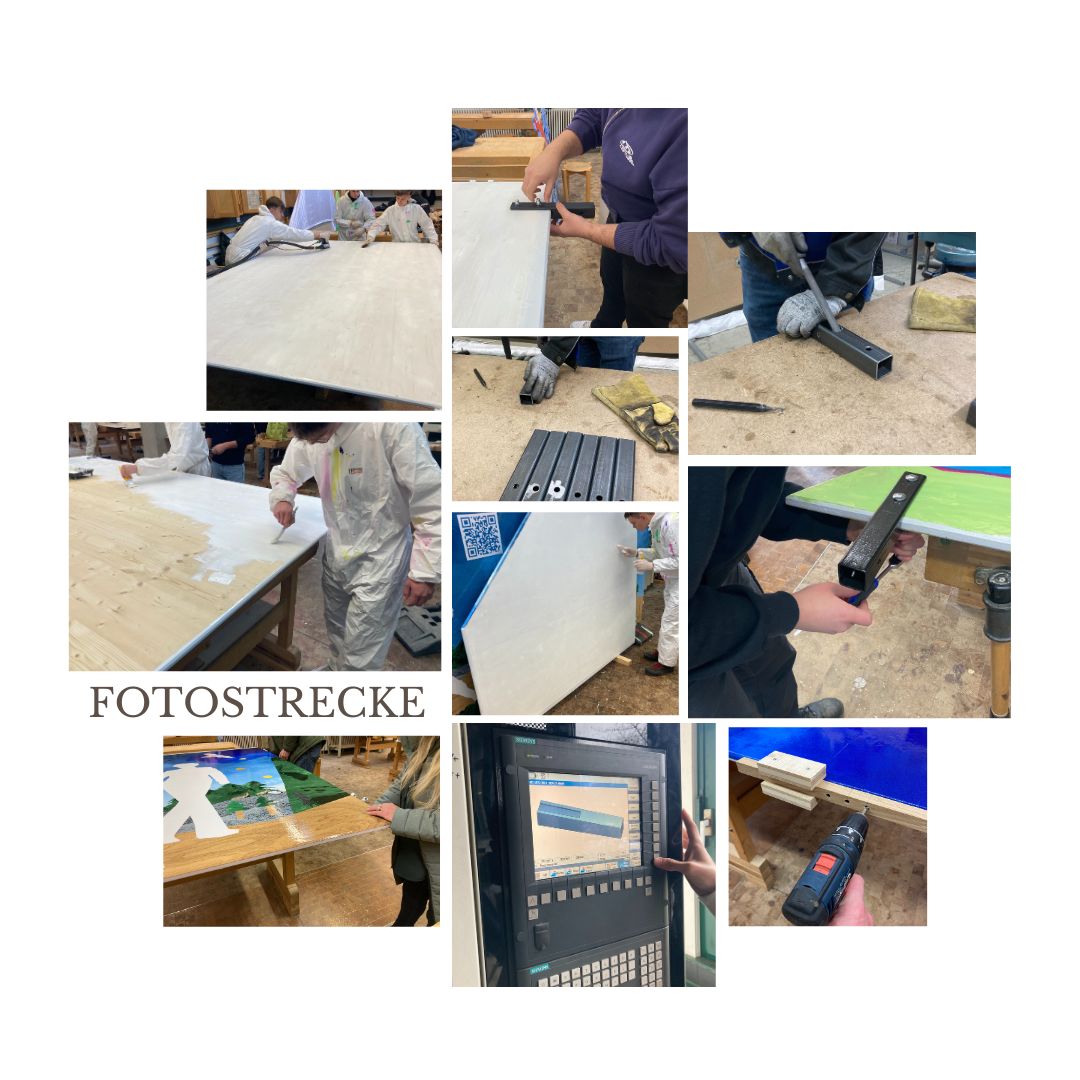Neumarkt arrives
Our nativity figures
Here you can find information about the figures in the walk-in nativity scene in Neumarkt
Neumarkt arrives
A brief introduction to each figure

Each figure tells its own story, namely the story of arrival. Joseph and Mary also set off at that time, they wanted to arrive and find a place that offered protection and safety. They found this in the manger.
Our figures in the walk-in nativity scene also deal with arrival. What does that mean for me? Where do I want to arrive? With myself? At work? In the community? In a home or in my sexuality? Everyone has found their own personal answer to the question of arrival. This is reflected in the characters, whether they are wheelchair users, men with depression, UN soldiers or mothers. They all want to arrive and find their own personal place that offers them protection and security.
Charity, inclusion and diversity are the values that can be found in all the characters. We are all different, have different abilities and different starting points and yet we all have the desire to be part of a community that allows everyone to arrive.
Be inspired by the unique creative works of these groups and find out more about the background to the individual designs!
#1 Two people meet
Jura workshops Neumarkt

Two people meet. They shake hands, looking forward amidst a colorful backdrop. Together they discover the world.
Getting around – moving on – arriving. Aids such as wheelchairs make it possible for people with a physical impairment to be mobile and actively participate in social life. People with a mental or psychological impairment also want to be included without becoming disabled. Just as normal. In a broader sense, “arriving” can mean finding a place in the community and being accepted and respected for who you are. It is about breaking down barriers, whether physical or psychological, and creating an environment in which everyone can develop and feel comfortable.
The term “arriving” could also mean being heard and taken seriously and having an influence on decisions that affect one’s own life. For people with disabilities, this is still not a matter of course, even though it was legally established in 2009 in the UN Convention on the Rights of Persons with Disabilities. It is important that people with disabilities receive the support and resources they need to realize their wishes and goals. In this way, a society can be created in which every person is able to actively participate and lead a fulfilled life – be it at work, in their leisure time or in social interaction.
So let’s all join hands and move forward together. This is how we will move forward together and arrive in a society that breaks down barriers and meets each other.
The walk-in nativity scene shows a sad yet smiling man arriving in Neumarkt at Christmas time in front of the Reitstadel.
Holzmichl lives with depression and often feels depressed, desperate and anxious.
On the other hand, he beams a smile, which he likes to put on as a kind of mask so as not to attract attention. Only Michl knows how he really feels and what he looks like inside.
He has many worries that weigh heavily on the very sensitive Michl, symbolized by the globe in his hand.
In addition, Michl’s depression paralyzes him in coping with everyday life; for example, he has problems getting up in the morning and can no longer concentrate properly because he has trouble sleeping.
A heavy bag containing many heavy stones hangs from the walking stick. Michl’s problems and symptoms are written on the stones. This makes every movement difficult and inflexible.
But Michl also has another smiling side and takes his health into his own hands. His hand holds a ball and this ball contains, figuratively speaking, all the pieces of the mosaic that contribute to health and well-being. Michl shows everything that is important for his recovery process and how he himself contributes to maintaining his own health.
For Michl, arriving means feeling at home in his town, knowing people he gets on with, meeting and exchanging ideas with them and doing nice things. He enjoys going to the nativity scene exhibition in the Reitstadel.
The day center for mentally ill people and the social psychiatric service help Michl to live better with his illness. With counseling sessions and many different offers from the day center, Michl can participate in society again and find a way out of his illness.
You can find more information from the social psychiatric service and the day center (meeting place for people living with a mental illness) at www.diakonie-nah.de and Instagram.
#2 The woodcutter
Day center of Diakonie NAH e.V.

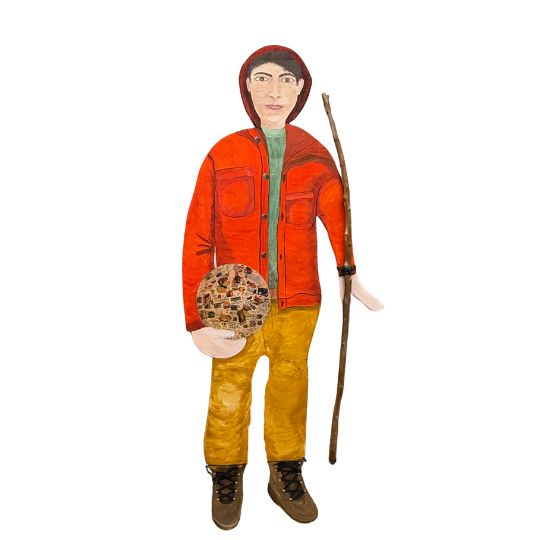
#3 Ministrant
Court church

The altar boy is representative of all children and young people who are involved in the church’s youth work.
Young people are committed to the spirit of Christian charity, because this is the message that the child in the manger brought us.
Ministries include a lively community. Friendships are formed, some of which last a lifetime. The children and young people learn that life involves a community that is as colorful as the different figures in the manger.
In this way, the altar boy symbolizes all the people who are at home in the church and who approach everyone openly in order to make the world a little bit better.
There is movement here!
Young people’s lives are colorful, diverse and dynamic. The skater symbolizes the vitality of young people, which is important for our society. In all areas of youth work, e.g. at the Kreisjugendring, clubs, associations or the church, young people bring vitality to life.
This figure is intended to bring the joy of life to the crib and the child lying there with open arms is intended to give his blessing to all children and young people.
#4 – Skater
Court church

#5 Mother
City of Neumarkt
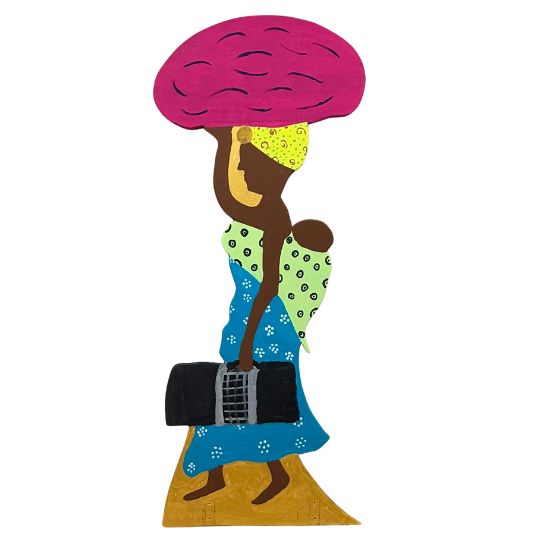
I, Rita Großhauser, deliberately chose the figure of a mother for our walk-in crib project – arriving moved.
A mother plays a very big, actually the most important role in the lives of all family members.
A mother is a selfless, loving person who must, but also wants to, sacrifice many of her own wants and needs for the wants and needs of her children. A mother works hard to ensure that her child is equipped with the knowledge, skills and abilities to develop into a competent but also empathetic human being.
Through the mother’s loving care and attention, the child learns that it is loved and valued. In this way, a child playfully learns to pass this on to others. Experiencing this is very fulfilling for a mother.
The livelihoods of many people are being destroyed by war and violence. Fields can no longer be cultivated, jobs are being destroyed, food is becoming scarce and prices are rising. Roads, bridges, electricity and water supplies and schools are damaged or destroyed.
Of course, a mother in such situations tries everything to give her offspring, her family, a future worth living. No matter what moves her, what path, what difficulties have to be overcome, a mother always fights to get the BEST for her loved ones. They sometimes embark on a dangerous journey, hoping to arrive safely in a place far from home, with open-hearted and friendly people.
In connection with the war in Ukraine, we pupils in Year 9 at Ostendorfer Gymnasium have been reflecting on the role of Bundeswehr soldiers and the role of the military in the population in general. We all agreed that there is a lack of appreciation and acceptance towards them. We explained this by the fact that only one of our classmates knew a soldier.
Since the suspension of military service in Germany, we and many other young people no longer have any points of contact and can identify less with soldiers. Perhaps we would also prefer to get involved in the peace movement, precisely because we hear a lot about the crimes of the Second World War at school, especially about the momentous role that Germany played in it.
Nevertheless, we can all see that we cannot do without soldiers and that they would always give their lives for us when deployed abroad.
For our nativity scene figure, we chose a blue helmet soldier, i.e. a soldier who is tasked by the United Nations (UN) with restoring peace in conflict regions and protecting the civilian population. We can imagine how stressful this must be and the fears that everyone has.
Our soldier lifts up a little girl. Perhaps he has just rescued her. Or maybe our soldier is a dad himself and has just come home from a mission and his child has run joyfully to meet him: Advent means arrival. And in any case – either way – it is a truly moving arrival.
#6 – Soldier with a girl
Ostendorf grammar school
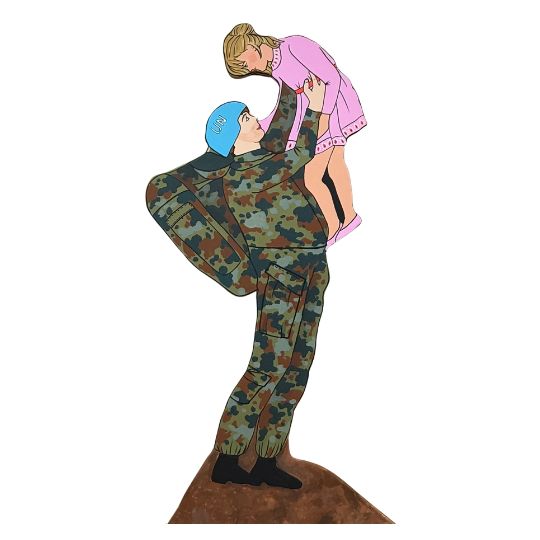
#7 Young girl
Pastoral care at Weinberg School & Regens Wagner
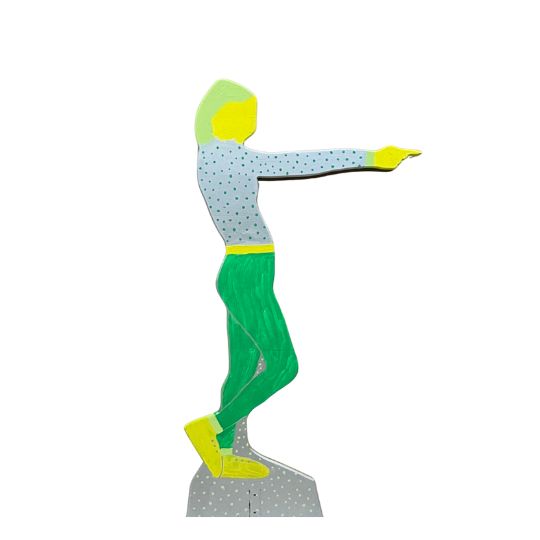
A young girl as a symbol of our journey together. In a world full of possibilities, the designed figure of a young girl stands as an inspiring symbol for the journey we are all embarking on. “Where should I go?” This fundamental question is on our minds, especially as students who want to actively shape our future. We are not only looking for goals, but also for clear paths to get there.
The figure of the girl symbolizes curiosity and the courage to explore new paths. “Who will show me a good path?” This question refers to the companions and mentors in our lives who support us on our path. It reminds us that we are not alone in our search for answers. “And when I arrive? Is there anyone there?” The longing for community and understanding is essential. Through dialog with others, we can broaden our perspectives and develop new ideas.
“It’s worth listening to us.” The young girl invites us to share our thoughts and break new ground together. By approaching each other and supporting each other, we open up numerous possibilities.
Let us see this figure as an inspiration to consciously walk our paths and accompany each other. By working together, we shape not only our future, but also the community in which we live. Together we can achieve great things.
The designed figure of a boy on a scooter embodies the diversity of our community. “We are different” – this is reflected in our different paces and looks, our different biographies and abilities, our ages and the colors of our cultures. But despite these differences, there is something that unites us all: The path we walk together.
Each of us brings a unique perspective that enriches our community.
We are all on a journey in search of our place in the world. “We all want to arrive.” This common longing for a destination, a place of belonging, unites us. The boy on the scooter symbolizes this dynamic and active path that we take to make our dreams come true.
“We all long for a place where we are accepted as we are” – with our colors, scars, desires and questions. Each scooter of life that we ride may be shaped differently, but it is the common desire for acceptance and understanding that drives us to keep riding and growing.
The figure of the boy on the scooter reminds us that there is immense strength in our diversity. By valuing and respecting each other, we can create a community where everyone is welcome and where we can all arrive. Let’s embark on this journey together and celebrate the beauty of our diversity.
#8 Boy on a scooter
Pastoral care at Weinberg School & Regens Wagner
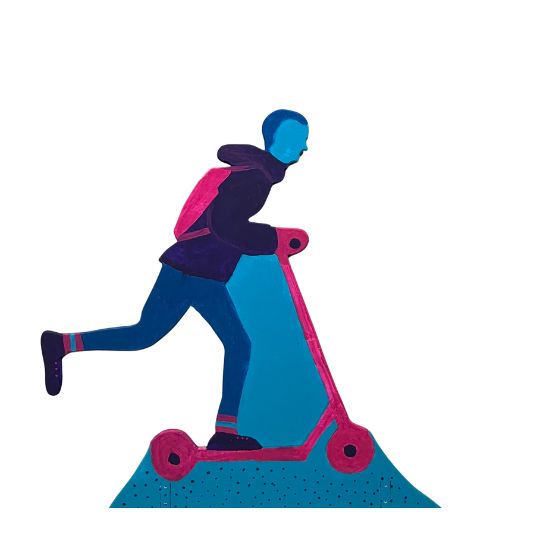
#9 Wheelchair user
Pastoral care at Weinberg School & Regens Wagner
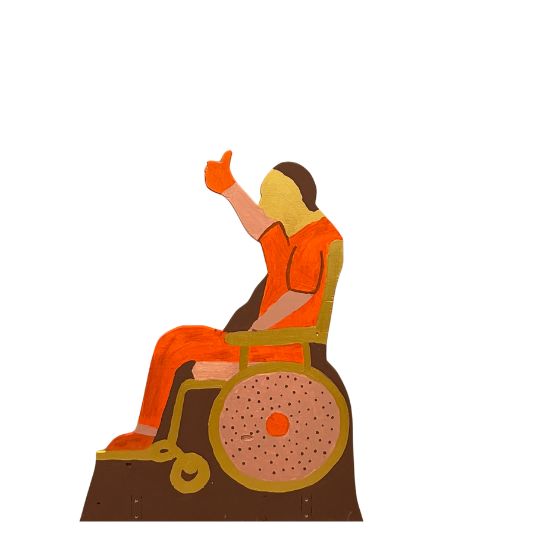
Thumbs up – this symbol is intended to represent the self-image and attitude to life of the residents of Group Anton at the Regens Wagner House in Dr. Schrauth Str. in Neumarkt.
In 2018, a centrally located living space for people with traumatic brain injury was created in the city center of Neumarkt.
Self. Determined. Life – not only within the residential group but also in the Neumarkt
social area.
The town of Neumarkt is always ready to listen to people with disabilities – barriers in everyday life are avoided or removed as far as possible so that everyone can live their lives as independently as possible. If a barrier does arise in everyday life, helping hands are often on hand.
Regens Wagner is very well integrated into the neighborhood and has become an integral part of social life.
The people at Regens Wagner feel at home in Neumarkt and look forward to many contacts in the future.
Thumbs up for creative cooperation!
The figure depicts a young man in his twenties, without clearly recognizable facial features. This is no coincidence, but a deliberate artistic device to show that identity and value are not tied to external features. This figure is Noah, but it could also be anyone else. She wants to express that Noah is dealing with issues such as diversity and toxic masculinity, questioning the superficiality of social expectations.
The outward appearance – overweight, dressed in jogging bottoms and a hoodie – may seem simple at first glance, but that is precisely where the challenge lies. It represents the image of a modern young adult, which clashes with classical ideas. A young man is often described as fit, muscular and full of energy to fit the ideal image of attractiveness and masculinity. But Noah aims to show that joie de vivre, well-being and masculinity have nothing to do with such external standards.
The empty facial features symbolize the idea that the figure could be anyone. It’s about society moving away from the idea of judging people by their appearance. The decision to portray Noah as overweight is a sign that body diversity exists and should be accepted without being burdened with negative connotations. Noah is not “fat but sweet” – he is simply himself, with all that that entails.”
His everyday clothing is a deliberate choice. It stands for the normality that many people live in. It is a break with the image of the constantly strong, flawless man who shows no weaknesses. The figure is intended to show that it is perfectly okay to have weaknesses and to be sensitive. Toxic masculinity often arises from the expectation to maintain a certain image of invulnerability and control. But true masculinity lies in acceptance, vulnerability and self-love.
Noah is meant to express a positive attitude towards life and the acceptance he has for himself. His excess weight is a part of him, but it does not define him. There is no need for justifications or euphemistic descriptions. Noah is happy and content because he is well – and that is exactly what the character wants to show the world. It is a strong statement against the silent norms that shape and restrict our image of the body and masculinity.
#10 – Noah – The face of diversity
Vocational school Neumarkt

#11 Footballer
Neumarkt secondary school for boys
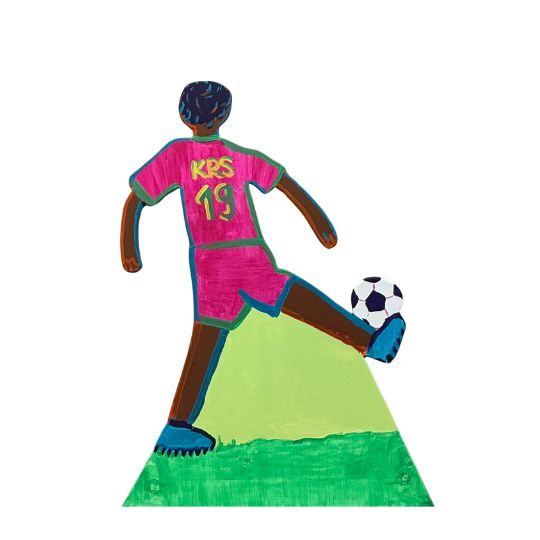
As our boys at the KRS are naturally interested in soccer for the most part and were in soccer fever in the wake of the European Championships taking place in Germany in 2024, the choice of a footballer as a nativity figure was an obvious one:
It stands for uniting people, for fair sportsmanship and, of course, for energy and joie de vivre.
He knows that every game is a new challenge. And he is often the center of attention: the hopes of the fans, the demands of the club, the expectations of his teammates.
He hopes for God’s help and runs to get ahead – or rather, to arrive:
For him, arriving means being true to yourself, giving your best and finding inner stability in respectful cooperation.
A punk is a very unusual character for a crèche group. He is actually regarded as a social outsider, is not always conformist or even well-behaved; sometimes he is even provocative and dismissive. But even underneath his mohawk and studs, he is a person with feelings.
The question of what led to his often self-imposed departure from the conformity of society can usually only be answered individually. The biblical figures were also outsiders: Mary and Joseph were socially underestimated and even had to make do with a stable for the birthplace of their son. It was precisely this son, born in such an unusual way, who later often went against the conventions of the recognized religious representatives and the state.
Punk also questions many things. There is a stylized crib on the back of his studded leather jacket – it shines brighter than the sharp studs. He needs a compass to help him find his way. For him, arriving means finding peace with his environment and himself.
#12 – Punk
Neumarkt secondary school for boys
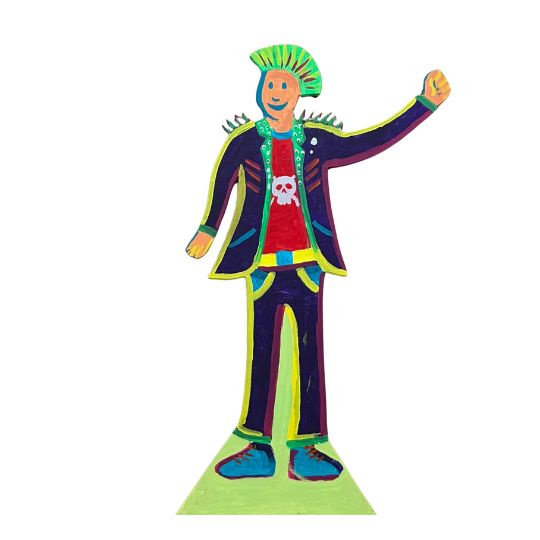
#13 Street musician
Neumarkt secondary school for boys
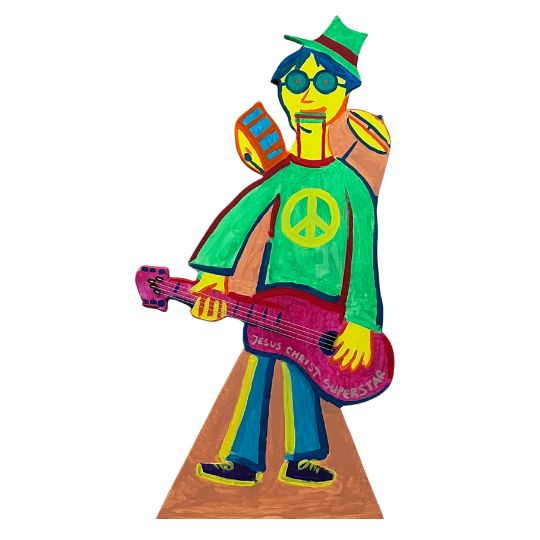
The street musician is another character who does not fit into the usual mold:
He usually takes an unorthodox approach to the instrument – whether he builds it himself or simply repairs it. He is creative and often non-conformist: Whether out of financial necessity, as instruments and their maintenance are often expensive, or out of artistic experimentation. He enjoys finding and inventing new sounds. Ultimately, only one thing counts for him: music is the key to people’s hearts and connects everyone – as in the poem by Johann Gottfried Säume: “Where one sings, there let yourself settle.”
In this respect, our street musician also acts as the connecting element between the footballer performing in the crowd and the more solitary punk: he brings everyone together and thus unites the outwardly incompatible. The Christmas carols are similar: they combine faith and secular entertainment music – they are catchy and cheerful and thus contain the joy of the birth of Jesus Christ. For this reason, the title of the musical “Jesus Christ Superstar” can also be found on his guitar – secular entertainment meets deeply felt faith.
For him, arriving means using his talents to bring people together at the crib and celebrate the birth of Jesus with them.
